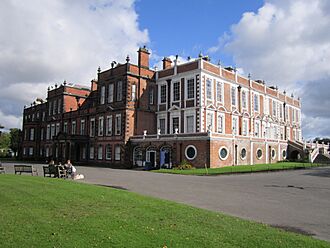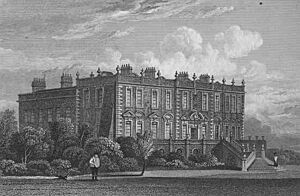Croxteth Hall facts for kids
Quick facts for kids Croxteth Hall |
|
|---|---|

Croxteth Hall in 2012
|
|
| General information | |
| Address | West Derby, Liverpool, England |
| Coordinates | 53°26′31″N 2°53′28″W / 53.442°N 2.891°W |
| Renovated | c. 1702, 1874–77 and 1902 (extended) |
| Designations | |
|
Listed Building – Grade II*
|
|
| Official name: Croxteth Hall | |
| Designated: | 28 June 1952 |
| Reference #: | 1280299 |
Croxteth Hall is a large country estate and a very important old building in West Derby, a part of Liverpool, England. It used to be the big home of the Molyneux family, who were also known as the Earls of Sefton.
When the last Earl died in 1972, the estate became owned by Liverpool City Council. They now look after the part that wasn't sold. The park around the hall, called Croxteth Park, was once a hunting ground for the family. Today, it is open for everyone to enjoy.
Contents
History of Croxteth Hall
The first part of Croxteth Hall was built around 1575. Over the years, it was made bigger in different styles. These styles include Tudor, Georgian, and Queen Anne. The main front of the house, facing west, was built in 1702.
In the past, the hall had its own bakery and brewery. These were later taken down during the Victorian times. A new part was added in 1874 for guests to stay in.
Royal Visit to Croxteth Hall
A very special event happened on October 9, 1851. Queen Victoria, Prince Albert, and their children stayed at Croxteth Hall. The next day, they visited Liverpool, even though it was raining heavily. The visit started well, with 700 important local people being entertained in the hall's grounds.
The Molyneux Family and the Hall
Croxteth Hall and its other buildings are considered very important historical sites. The Molyneux family lived there for a long time, from the 1500s until 1972. That's when the last Earl died.
His wife, Josephine, Countess of Sefton, was from America. She was known as "Foxy" because of her red hair. She continued to live at Croxteth for some time. She was the very last member of the Molyneux family to live in the hall.
Croxteth Park Today
After the last Earl died in 1972, people searched all over the world for someone to inherit his title. But they couldn't find anyone. A lot of the original land was sold off for building new homes.
However, about 500 acres (2.0 km2) of the estate remain. This area is now a country park that is open to everyone. It has fun play areas for children. The historic hall itself is also open to the public for a small fee.
The park also has a beautiful Victorian walled garden. There is also a working country farm that you can visit.
The Walled Garden and Plants
The walled garden at Croxteth Hall is home to what's left of the Liverpool Botanics. This is one of Britain's oldest plant collections. It was started by William Roscoe in 1802.
Inside, you can find many tropical plants. There is a special collection of Dracaena plants, also known as dragon trees. You can also see orchids and a collection of Codiaeum plants. There are also pelargoniums and a collection of Solenostemon (coleus). The garden also has many bromeliads. Liverpool was once famous for its orchids. This is because the collection mostly has wild orchids, not the ones grown in gardens.
Recent Changes and Future Plans
In March 2013, work began to fix the Queen Anne wing of the hall. This part was badly damaged by a fire in 1952. The repairs cost about £400,000.
In 2017, Liverpool City Council looked for companies to manage the hall and park. It cost the council over £1 million a year to run. By January 2018, two companies offered to take over. One idea was to turn the hall into a fancy hotel, spa, and wedding place.
However, in March 2018, the council decided to keep running the hall and park themselves. They planned to make it a bigger tourist attraction. They wanted to host concerts, fairs, and markets there.
In the summer of 2020, the hall needed urgent repairs. An engineering report found that chimneys, gutters, and roof linings needed fixing. This work cost around £650,000.
The Park at Croxteth
The park itself is also very important and is a country park. It includes Mull Wood, which is part of the 85-hectare Croxteth Local Nature Reserve. The reserve was made twice as big with help from the Lancashire Wildlife Trust. This means more people can visit the reserve areas. It also includes new types of natural areas. One improvement in Mull Wood is a new Wildflower Meadow near the Old Kennels.
Myerscough College has its Liverpool campus at part of the hall. They teach about 350 full-time students there. You can find more information on their website.
The "Friends of Croxteth Hall and Country Park" is a group that helps support this important home. The Friends hold many fun events to raise money. They have paid for things like benches, plants, and equipment for the park.
Every Saturday morning at 9 a.m., the park hosts a free 5 km running event called parkrun. It starts and finishes at the hall.
The Kennels
The kennels at Croxteth Hall Lane were built in the 1870s. They are also a very important old building. They were designed by an architect named John Douglas for the 4th Earl of Sefton.
The kennels are made of red brick with a roof that has blue and green slates in a pattern. The building has one floor and three sections. The two sections on the left were the kennels. The section on the right is taller with a steeper roof. There is also a tall brick chimney. The kennels are currently used and looked after by the Croxteth Park Volunteer Group, which started in 2017.
See also
- Grade II* listed buildings in Liverpool – Suburbs
- Grade II* listed buildings in Merseyside


